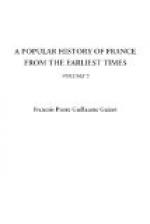this idea, and testified a desire for this double
marriage, but without taking any trouble to bring
it about. It was after his death that, on the
30th of April, 1612, Villeroi, minister of foreign
affairs in France, and Don Inigo de Caderiias, ambassador
of the King of Spain, concluded this double union
by a formal deed. They signed on the same day,
at Fontainebleau, between the King and Queen-regent
of France on one side and the King, of Spain on the
other, a treaty of defensive alliance to the effect
“that those sovereigns should give one another
mutual succor against such as should attempt anything
against their kingdoms or revolt against their authority;
that they should, in such case, send one to the other,
at their own expense for six months, a body of six
thousand foot and twelve hundred horse; that they
should not assist any criminal charged with high treason,
and should even give them over into the hands of the
ambassadors of the king who claimed them.”
It is quite certain that Henry IV. would never have
let his hands be thus tied by a treaty so contrary
to his general policy of alliance with Protestant powers,
such as England and the United Provinces; he had no
notion of servile subjection to his own policy, but
he would have taken good care not to abandon it; he
was of those, who, under delicate circumstances, remain
faithful to their ideas and promises without systematic
obstinacy and with a due regard for the varying interests
and requirements of their country and their age.
The two Spanish marriages were regarded in France
as an abandonment of the national policy; France was,
in a great majority, Catholic, but its Catholicism
differed essentially from the Spanish Catholicism:
it affirmed the entire separation of the temporal
power and the spiritual power, and the inviolability
of the former by the latter; it refused assent, moreover,
to certain articles of the council of Trent.
It was Gallican Catholicism, determined to keep a
pretty large measure of national independence, political
and moral, as opposed to Spanish Catholicism, essentially
devoted to the cause of the papacy and of absolutist
Austria. Under the influence of this public feeling,
the two Spanish marriages and the treaty which accompanied
them were unfavorably regarded by a great part of
France: a remedy was desired; it was hoped that
one would be found in the convocation of the states-general
of the kingdom, to which the populace always looked
expectantly; they were convoked first for the 16th
of September, 1614, at Sens; and, afterwards, for
the 20th of October following, when the young king,
Louis XIII., after the announcement of his majority,
himself opened them in state. Amongst the members
there were one hundred and forty of the clergy, one
hundred and thirty-two of the noblesse, and one hundred
and ninety-two of the third estate. The clergy
elected for their president Cardinal de Joyeuse who
had crowned Mary de’ Medici; the noblesse Henry
de Bauffremont, Baron of Senecey, and the third estate
Robert Miron, provost of the tradesmen of Paris.




